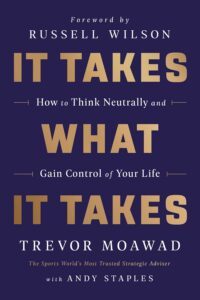“It Takes What It Takes: How to Think Neutrally and Gain Control of Your Life,” Trevor Moawad, a renowned mental coach in the sports arena, spills the beans on how elite athletes, savvy coaches, and even special forces achieve their top-level performance. Moawad, who has worked with the likes of Nick Saban and Russell Wilson, introduces a unique concept that he coins as “neutral thinking.”
This is not your typical motivational jargon that leans on either relentless positivity or tackling negativity. Rather, it’s a balanced, clear-cut method that allows individuals to objectively analyze situations, thereby offering supreme clarity and calmness, especially in those nail-biting moments when decisive action is crucial.
related: Summary of Peak: Secrets from The New Science of Expertise
Moawad goes a step further by applying this philosophy to life beyond the field or court. Imagine being a teacher dealing with a difficult student, or a parent stuck in the labyrinth of teenage emotions; neutral thinking could well be your ticket to making better decisions.
The principle essence is to coolly assess situations without the emotional baggage of past failures or the irrational exuberance that comes with a streak of successes. Moawad insists that the past should not be seen as predictive; letting go of it can instantly make you feel more composed. And the more composed you are, the better your awareness and decision-making will be.
This mental approach not only impacts professional performance but extends its influence to various facets of life. The essence of neutral thinking is universal and can be applied by anyone looking to gain an edge, be it in sports, academics, parenting, or relationships. Whether you’re planning your next classroom strategy or navigating through the complexities of parenthood, adopting neutral thinking can offer you a clear, unobstructed path to achieving your goals.
It Takes What It Takes Discussion Questions
Here are some thought provoking questions that can help readers and educators ponder over the key concepts presented in “It Takes What It Takes”:
- How does neutral thinking differ from positive or negative thinking, and what are the advantages or disadvantages of each approach?
- Do you agree with Moawad’s mantra that “the past isn’t predictive”? How could this philosophy be applied in educational settings or parenting?
- Moawad’s philosophy extends beyond the realm of professional athletes. Can you think of a situation in your own life where neutral thinking could have made a difference?
- The book discusses the concept of ‘letting go’ as crucial to adopting neutral thinking. How easy or difficult is it for you to let go of past failures or successes? What strategies might help you become better at this?
- How do you think neutral thinking can affect team dynamics, whether in sports, the workplace, or in collaborative educational projects?
- Moawad talks about heightened awareness as a result of being more calm. Have you ever experienced this, and if so, how did it impact your decision-making?
- What are some practical ways to start incorporating neutral thinking into your daily routine?
- How could the principles of neutral thinking be integrated into educational curricula to benefit students’ decision-making and stress management skills?
- Moawad’s client base is primarily elite athletes and special forces. Do you think his methods are applicable to ‘everyday’ people? Why or why not?
- After reading the book, has your perspective on mental coaching changed? If yes, how?
Final thoughts
“It Takes What It Takes: How to Think Neutrally and Gain Control of Your Life” by Trevor Moawad and Andy Staples is a compelling read that moves beyond the conventional wisdom of positive thinking. It introduces us to the art of neutral thinking, a mental approach that encourages objective evaluation, clear decision-making, and ultimately, improved performance in various facets of life. From the high-stakes world of elite athletes to the everyday challenges faced by teachers, parents, and professionals, the principles of neutral thinking offer a fresh perspective that’s worth considering.
I hope you find this It Takes What It Takes summary helpful!







